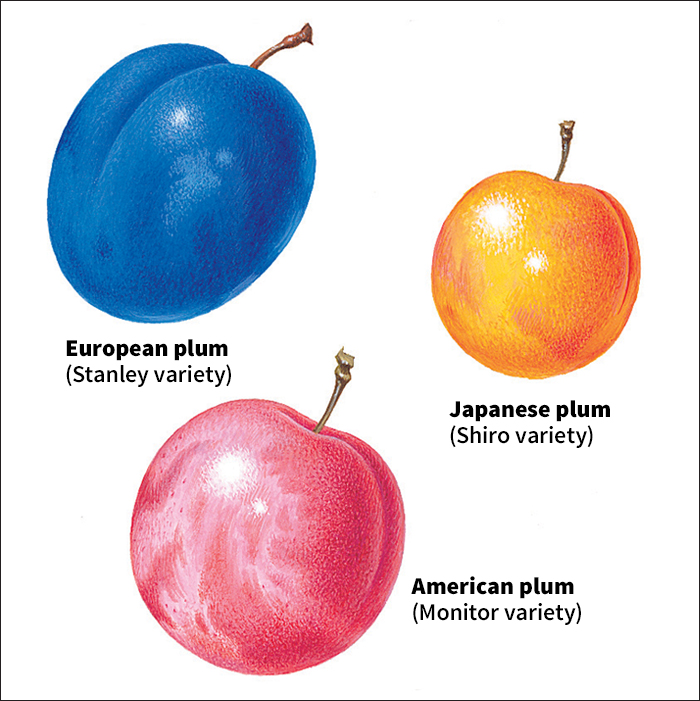Plum is a popular fruit that is eaten fresh or used to make jams, jellies, and preserves. Some types of plums are dried to make prunes.
Plums grow on trees that range in height from 7 to 18 feet (2 to 5 meters). Plums have a smooth, thin skin surrounding a thick, juicy flesh. A hard pit in the center of the fruit contains one or two seeds. Plums may be heart-shaped, oval, or round. Cultivated varieties measure from 1 to 21/2 inches (25 to 64 millimeters) in diameter. They may be black, blue, green, purple, red, or yellow, depending on the variety.
About 61/2 million short tons (6 million metric tons) of plums are produced in the world each year. The leading plum-producing countries include China, Germany, and the United States. The United States produces about 1 million tons (0.9 million metric tons) of plums each year. California produces far more plums than all the other states combined. In Canada, British Columbia and Ontario are the leading plum-growing provinces.

Kinds of plums.
There are three main kinds of plums: (1) European, (2) Japanese, and (3) American. There are several cultivars (cultivated varieties) within each type.
European plums,
often called domesticas, originated in southwestern Asia, but they have been grown in Europe for more than 2,000 years. In the 1600’s, European plums were introduced into what is now Massachusetts. In the 1700’s, Spanish missionaries brought them to California. Important cultivars include Bradshaw, Grand Duke, Jefferson, Lombard, Reine Claude, and Stanley. Certain cultivars of European plums with high sugar content are primarily dried to make prunes.
Japanese plums
are native to China, but they were first cultivated in Japan. In 1885, Luther Burbank, an American horticulturist, introduced them into California. Japanese plums are generally firm and juicy and are usually eaten fresh. Cultivars include Abundance, Burbank, Santa Rosa, and Shiro.
American plums
grow on trees that were developed from wild plum trees of North America. The trees are not widely cultivated, but they can survive in much colder climates than European and Japanese plum trees can. Cultivars of American plums include Cheney, De Soto, Golden Beauty, and Monitor.
Growing plums.
Growers produce plum trees by attaching buds of commercially desirable cultivars onto a rootstock (root system and stem from another plant). Together they make a sturdier tree (see Grafting). For example, several species of American plum trees are useful as rootstocks for European and Japanese plums. Growers plant plum trees about 20 feet (6 meters) apart and carefully prune them during the first few years of growth to form well-shaped trees.
Plum trees generally flower from one to five years after planting. They produce beautiful white blossoms in the early spring that, if pollinated, develop into mature fruit by late summer. Most cultivars of plum trees are self-unfruitful—that is, they cannot produce fruit with their own pollen and must be pollinated by another cultivar within the same type. Both wild bees and bees from beehives that growers place in their orchards are important for carrying pollen from tree to tree.
Diseases and pests.
Major diseases that infect plum trees include the fungal diseases black knot and brown rot (see Rot). Growers control these diseases by removing and destroying infected parts of the trees, or by spraying the trees with fungicides. Plum curculio is a serious insect pest that damages the fruit by laying eggs underneath the skin. This pest is controlled through the use of insecticide sprays.
